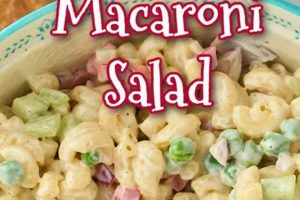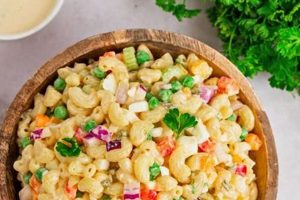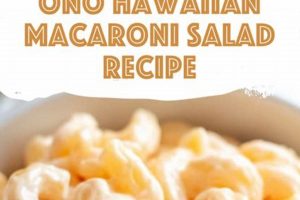A classic side dish, this type of salad typically features cooked elbow macaroni, mayonnaise, and a blend of simple ingredients like celery, onion, and sweet pickle relish. Variations may include hard-boiled eggs, mustard, vinegar, or other seasonings to enhance the flavor profile. A basic version offers a creamy, tangy, and slightly sweet counterpoint to heavier main courses.
This dish represents an economical and convenient option for picnics, potlucks, and everyday meals. Its adaptability allows for customization based on personal preferences and available ingredients. Historically, macaroni salads gained popularity in the mid-20th century as refrigeration became more common, enabling safe preparation and storage of mayonnaise-based dishes. The dishs relatively simple preparation and satisfying flavor contributed to its enduring appeal.
The following sections will explore the various components of creating this dish, from ingredient selection and preparation techniques to variations and serving suggestions. Guidance will be offered on achieving the ideal texture and flavor balance, ensuring a successful culinary outcome.
Tips for a Superior Macaroni Salad
Achieving a well-balanced and flavorful macaroni salad depends on attention to detail throughout the preparation process. These tips offer guidance for optimizing both texture and taste.
Tip 1: Cook Macaroni Properly: Macaroni should be cooked al dente, or firm to the bite. Overcooked macaroni results in a mushy texture. Rinse cooked macaroni under cold water to stop the cooking process and maintain firmness.
Tip 2: High-Quality Mayonnaise Matters: The mayonnaise serves as the foundation of the salad’s flavor. Opting for a high-quality mayonnaise significantly impacts the overall taste.
Tip 3: Fresh Ingredients Enhance Flavor: Freshly chopped celery, onion, and other vegetables contribute brighter flavors and crisp textures. Pre-chopped vegetables may offer convenience, but using fresh ingredients is recommended whenever possible.
Tip 4: Balance Sweet and Tangy Elements: Achieving the desired balance of sweet and tangy flavors is crucial. Adjust the amounts of sweet pickle relish, vinegar, or mustard to achieve personal preferences.
Tip 5: Seasoning is Key: Salt and pepper enhance the other flavors present in the salad. Taste and adjust seasonings throughout the preparation process.
Tip 6: Chill Thoroughly Before Serving: Chilling allows the flavors to meld and enhances the creamy texture of the salad. Refrigerate for at least one hour before serving.
Tip 7: Consider Textural Variety: Adding chopped hard-boiled eggs or shredded carrots provides textural contrast and visual appeal.
Tip 8: Proper Storage Extends Shelf Life: Store leftover macaroni salad in an airtight container in the refrigerator for up to three days. Beyond this point, quality may deteriorate.
By following these tips, one can elevate a simple macaroni salad from ordinary to exceptional. Attention to ingredient quality, proper cooking techniques, and flavor balancing ensures a satisfying culinary experience.
The following section will offer specific recipe variations and serving suggestions to inspire culinary creativity.
1. Elbow Macaroni
Elbow macaroni stands as the foundational ingredient in a simple macaroni salad recipe with mayonnaise. Its shape, texture, and ability to absorb flavors contribute significantly to the dish’s overall character. Understanding these attributes clarifies its essential role.
- Shape and Structure
The curved, hollow shape of elbow macaroni allows it to hold onto the creamy mayonnaise dressing, ensuring even coating and flavor distribution. This shape also creates pockets that trap smaller ingredients, preventing them from sinking to the bottom of the salad. Furthermore, the structural integrity of elbow macaroni prevents it from becoming overly mushy, even when mixed with other ingredients.
- Texture and Mouthfeel
Properly cooked elbow macaroni offers a pleasant, slightly firm texture that contrasts with the creaminess of the mayonnaise. This textural interplay adds to the overall sensory experience of the salad. Overcooked macaroni, however, can disrupt this balance, resulting in a less appealing, mushy texture.
- Flavor Absorption
Elbow macaroni readily absorbs the flavors of the dressing and other ingredients, resulting in a cohesive and well-balanced flavor profile. The porous nature of the pasta allows it to soak up the mayonnaise, vinegar, mustard, and seasonings, creating a harmonious blend of tastes.
- Visual Appeal
The uniform size and shape of elbow macaroni contribute to the visual appeal of the salad, creating a consistent and recognizable appearance. This visual consistency reinforces the classic nature of the dish. While other pasta shapes can be used, elbow macaroni’s distinct form remains the standard for classic presentations.
The characteristics of elbow macaroni contribute significantly to the success of a simple macaroni salad recipe with mayonnaise. Its shape promotes even dressing distribution and ingredient integration, while its texture and flavor absorption capabilities create a balanced and satisfying culinary experience. Choosing the correct pasta shape is therefore essential for achieving the desired outcome.
2. Mayonnaise (essential)
Mayonnaise constitutes the foundational element of a simple macaroni salad, acting as both a binding agent and primary flavor contributor. Its creamy texture and tangy flavor profile significantly influence the overall sensory experience. Understanding mayonnaise’s role in this context is crucial for achieving a successful outcome.
- Emulsification and Binding
Mayonnaise functions as an emulsifier, binding the disparate ingredients of the salad together. The emulsification process combines oil and vinegar, creating a stable mixture that coats the macaroni and other components. This cohesive quality prevents the salad from becoming watery or separating, ensuring a pleasant texture and consistent flavor distribution.
- Flavor Profile and Balance
Mayonnaise contributes a rich, creamy flavor with a subtle tanginess that complements the other ingredients. This tanginess, derived from vinegar or lemon juice, balances the sweetness often found in macaroni salad from ingredients like sweet pickle relish or sugar. The creamy texture enhances the mouthfeel, adding a layer of richness to the overall experience.
- Texture and Mouthfeel Enhancement
The creamy consistency of mayonnaise creates a smooth mouthfeel, contrasting with the firmer texture of the macaroni and vegetables. This interplay of textures adds depth and complexity to the salad. The viscosity of the mayonnaise also helps to coat the other ingredients, ensuring that each bite delivers a balanced combination of flavors and textures.
- Variations and Flavor Customization
Different types of mayonnaise, such as those with added flavors like herbs or spices, can be utilized to further customize the salad’s flavor profile. Additionally, the amount of mayonnaise used can be adjusted to achieve the desired creaminess and flavor intensity. This adaptability allows for personalization and experimentation within the basic recipe framework.
The role of mayonnaise in a simple macaroni salad extends beyond simply holding the ingredients together. Its contribution to flavor, texture, and overall sensory experience establishes it as a crucial component. The quality and type of mayonnaise selected, along with its balanced incorporation, directly influence the final product’s success. Careful consideration of these factors ensures a flavorful and well-balanced macaroni salad.
3. Complementary Vegetables
Complementary vegetables play a crucial role in a simple macaroni salad recipe with mayonnaise, contributing texture, flavor, and visual appeal. These additions move the dish beyond simple starch and fat, offering nutritional value and enhancing the overall sensory experience. The selection and preparation of these vegetables significantly influence the final product.
Common choices include celery, onion, and bell peppers, each offering distinct characteristics. Celery provides a crisp, refreshing crunch and a slightly vegetal flavor. Onion, whether red or white, adds a pungent bite and aromatic complexity. Bell peppers introduce sweetness and visual interest with their vibrant colors. Other vegetables, such as chopped carrots, shredded cabbage, or diced pickles, can also be incorporated, offering further textural and flavor variations. The quantity and variety of vegetables used can be adjusted to suit individual preferences and dietary needs. For example, a salad emphasizing a sweeter profile might incorporate more bell peppers and carrots, while one seeking a sharper flavor could include more red onion and diced pickles. Blanching certain vegetables, like carrots or bell peppers, can soften their texture while preserving their color and nutrients. The interplay of flavors and textures among these components elevates the salad from basic to complex.
Careful consideration of complementary vegetables is essential for creating a well-balanced and flavorful macaroni salad. These additions provide not only nutritional value but also enhance the textural and visual appeal. Understanding the contributions of various vegetables allows for informed choices that align with individual preferences and desired outcomes. The strategic incorporation of complementary vegetables distinguishes a truly satisfying macaroni salad.
4. Seasoning Adjustments
Seasoning adjustments represent a critical step in perfecting a simple macaroni salad recipe with mayonnaise. They elevate the dish beyond basic flavors, creating depth and complexity. A balanced approach to seasoning enhances the inherent qualities of the ingredients, transforming the salad from palatable to exceptional. Careful consideration of these adjustments allows for customization and ensures a satisfying culinary experience.
- Salt and Pepper
Salt and freshly ground black pepper form the foundation of seasoning in macaroni salad. Salt enhances the flavors of other ingredients, while pepper adds a subtle bite. The quantity of each should be adjusted to taste, considering the saltiness of other components like mayonnaise and pickles. Proper seasoning with salt and pepper is crucial for achieving a balanced flavor profile.
- Vinegar and Acidity
A touch of vinegar, typically white or apple cider, introduces a bright, acidic note that balances the richness of the mayonnaise and sweetness of other ingredients. This acidity enhances the overall flavor profile, preventing the salad from becoming overly heavy or cloying. Lemon juice can also be used as a substitute, offering a similar acidic counterpoint. The amount of vinegar or lemon juice added should be adjusted to personal preference.
- Mustard for Tang
Mustard, particularly Dijon or yellow mustard, adds a tangy complexity and depth of flavor. It complements the mayonnaise and vinegar, enhancing the overall savory profile of the salad. Mustard also contributes a subtle heat, adding another layer of dimension. The type and amount of mustard used can be adjusted to achieve the desired level of tang and complexity.
- Sugar for Balance
A small amount of granulated sugar or a pinch of powdered sugar can subtly enhance the sweetness and balance the other flavors in the salad. This adjustment is particularly relevant when using less sweet pickles or aiming for a more pronounced sweet and tangy profile. However, caution is advised to avoid excessive sweetness, which can overpower the other flavors.
Strategic seasoning adjustments are essential for transforming a simple macaroni salad from ordinary to extraordinary. The interplay of salt, pepper, acidity, tang, and sweetness creates a complex and balanced flavor profile that enhances the inherent qualities of the ingredients. Careful attention to these elements elevates the culinary experience, resulting in a truly satisfying and flavorful macaroni salad.
5. Chilling Period
The chilling period represents a crucial, often overlooked, step in preparing a simple macaroni salad recipe with mayonnaise. This period of refrigeration allows the flavors of the various components to meld and harmonize, resulting in a more cohesive and flavorful final product. Beyond flavor development, chilling also impacts the texture and overall quality of the salad.
- Flavor Development
Chilling allows the ingredientsmacaroni, mayonnaise, vegetables, and seasoningsto fully interact and develop their flavors. The absorption of the dressing and seasonings by the macaroni intensifies over time, resulting in a more pronounced and well-rounded flavor profile. This melding of flavors elevates the salad from a simple combination of ingredients to a more complex and satisfying culinary experience. The longer the chilling period, up to a point, the more pronounced this effect becomes.
- Texture Enhancement
Refrigeration firms the macaroni, enhancing its textural contrast with the creamy mayonnaise. This cooling process also allows the mayonnaise to thicken slightly, contributing to a more desirable consistency. The overall result is a salad with a balanced interplay of texturesfirm yet creamycreating a more pleasurable mouthfeel. A chilled salad offers a more refreshing experience, particularly in warmer weather.
- Food Safety Considerations
Chilling is essential for food safety, especially in mayonnaise-based salads. Refrigeration inhibits the growth of bacteria that can cause foodborne illness. Maintaining a safe temperature below 40F (4C) is crucial for minimizing risks. This underscores the importance of prompt refrigeration after preparation. While some ingredients, such as hard-boiled eggs, might benefit from a brief cooling period before incorporation, the final mixed salad should be chilled promptly and thoroughly.
- Optimal Serving Temperature
A chilled macaroni salad offers the most desirable sensory experience. The cool temperature enhances the refreshing qualities of the dish, making it particularly appealing during warmer months or as an accompaniment to heavier meals. The flavors are also perceived more distinctly when served cold, further emphasizing the importance of the chilling period. A room-temperature macaroni salad may taste bland or have a less appealing texture.
The chilling period in a simple macaroni salad recipe with mayonnaise is more than just a waiting period; it is an essential step that significantly impacts the final product’s flavor, texture, and safety. This seemingly passive process plays an active role in creating a more balanced, flavorful, and enjoyable culinary experience. Understanding the importance of proper chilling elevates the preparation of this simple dish to a more refined culinary endeavor.
Frequently Asked Questions
This section addresses common inquiries regarding the preparation and enjoyment of macaroni salad made with mayonnaise.
Question 1: What type of mayonnaise is recommended for macaroni salad?
While personal preferences vary, a high-quality, full-fat mayonnaise generally yields the best results in terms of flavor and texture. Lower-fat or fat-free versions may result in a thinner consistency and less rich flavor.
Question 2: Can other pasta shapes be substituted for elbow macaroni?
While other small pasta shapes, such as shells or rotini, can be used, elbow macaroni is traditionally preferred due to its ability to hold the dressing effectively and its classic association with the dish.
Question 3: How long can macaroni salad be stored in the refrigerator?
Macaroni salad containing mayonnaise should be stored in an airtight container in the refrigerator for no more than three to five days. Beyond this timeframe, quality and safety may be compromised.
Question 4: How can one prevent macaroni salad from becoming watery?
Ensuring the macaroni is cooked al dente and cooled thoroughly before combining with other ingredients helps prevent excess moisture. Using a high-quality mayonnaise and avoiding overmixing also contribute to a desirable consistency.
Question 5: Can macaroni salad be frozen?
Freezing macaroni salad is generally not recommended. The mayonnaise-based dressing tends to separate and break down upon thawing, resulting in an undesirable texture. Freezing also affects the texture of the vegetables, often rendering them mushy.
Question 6: How can one customize the flavor of macaroni salad?
Flavor customization can be achieved through various additions, including different types of mustard, herbs, spices, or vegetables. Adjusting the amount of vinegar or sweetness further allows for personalized variations.
Careful consideration of these frequently asked questions facilitates successful preparation and enjoyment. Attention to detail throughout the process optimizes the flavor, texture, and overall quality of the final product.
This concludes the frequently asked questions section. The following section will provide a complete, easy-to-follow recipe for creating a classic macaroni salad.
Simple Macaroni Salad Recipe with Mayo
This exploration of a simple macaroni salad recipe with mayonnaise has highlighted the essential components and techniques that contribute to a successful outcome. From the selection and preparation of elbow macaroni to the crucial role of mayonnaise, each element contributes to the final product’s overall quality. Complementary vegetables, seasoning adjustments, and the chilling period further enhance the flavor, texture, and sensory experience. Understanding the interplay of these factors allows for informed choices that elevate this seemingly simple dish to a culinary achievement.
The enduring popularity of macaroni salad speaks to its adaptability and enduring appeal. Its simplicity belies the potential for nuanced flavor profiles and customized variations. By appreciating the fundamental principles outlined herein, one can consistently create a satisfying and flavorful macaroni salad that complements a variety of meals and occasions. Continued exploration of ingredient combinations and flavor profiles promises further culinary enjoyment and enduring satisfaction.






